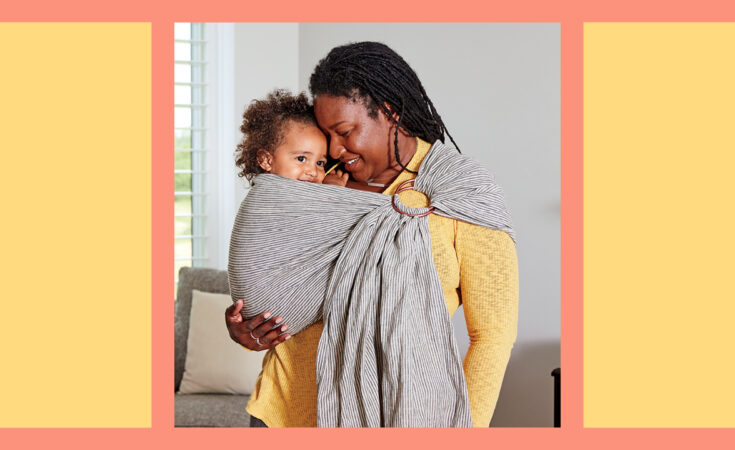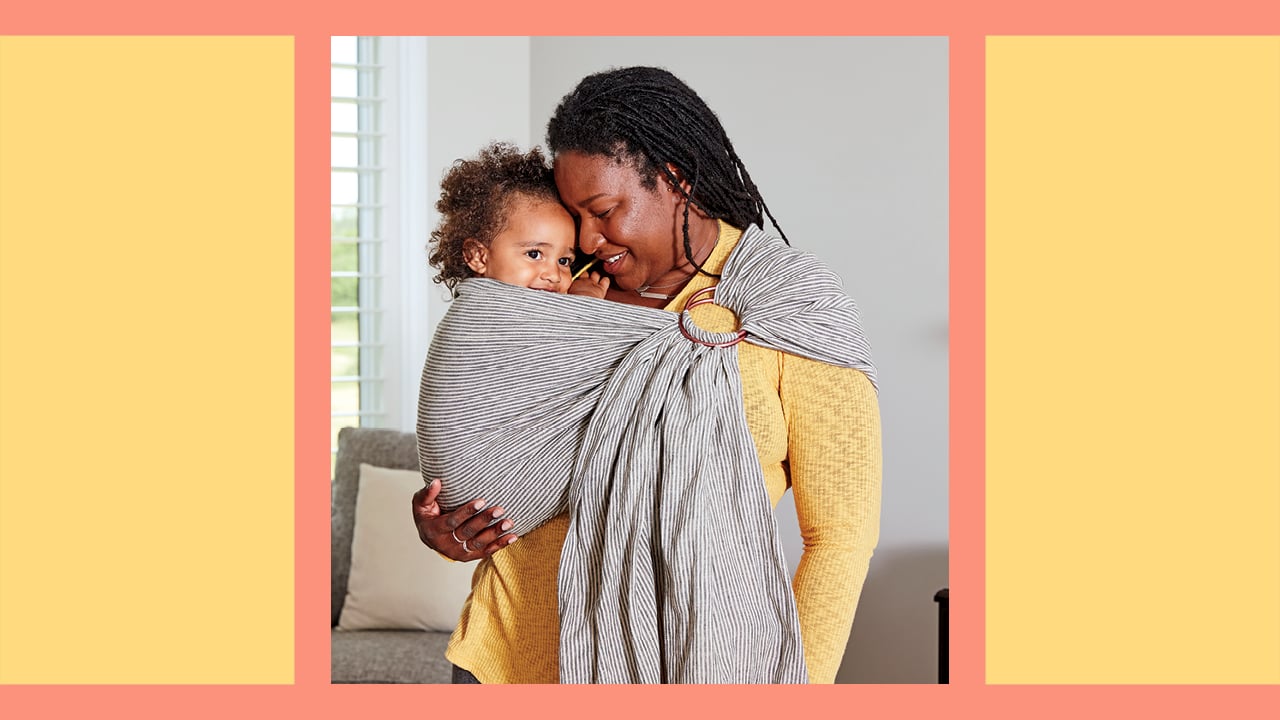Babywearing is a great way to keep your little one close, happy and secure while supporting their intense need for attachment in the early weeks and months—they just want to snuggle up and recreate the womb! It often leads to a calmer baby—and a calmer parent, too. Plus, for some infants, carrier naps are sometimes the only surefire way to get them to sleep. This is why, as a midwife and certified babywearing educator, I recommend starting as soon as you’re feeling ready. I also have four kids, and believe me, you’re going to want to have your hands free to get stuff done around the house or simply to feed yourself.
You may feel ready a few days after your baby is born, or several weeks after, depending on your delivery and whether you’re up and about or still happily resting in bed. Common reasons to hold off include pain, pressure or discomfort in your pelvis, or a smaller baby who is not yet an appropriate size to be worn safely. (Most carriers are designed for infants 7 or 8 pounds and up.)
If you had a C-section, babywearing for brief periods should be OK because newborns are fairly light, and your carrier shouldn’t rub against your incision. (Most carriers, slings and wraps for newborns should be worn much higher than your waist, with the baby’s head at your chest level.) But it’s always best to listen to your body and discuss it with your doctor or midwife. Please don’t rush if it’s not feeling right or has been discouraged by your healthcare team—you have lots of time to babywear, I promise.
The learning curve in the first few weeks with a new baby is steep, so go easy on yourself. No one needs to babywear to be a good parent. But eventually, a carrier can really make the days easier.
1. Think about where you’ll be babywearing
Before you make a purchase, think about what you will be doing while wearing your baby. Are you looking to keep your newborn snug and cozy while hanging out at home? Are you due in the colder months, or the warmer months? Are you a super active family headed out on the trails every weekend? Are you looking for a good all-purpose carrier to keep baby secure while doing stuff like daily errands, or while chasing after a busy toddler? Or do you live in a very hot climate (or are planning a hot weather trip) and need to consider the weather? Knowing what types of activities you will primarily be using your carrier for can help determine which one is a good fit for your family.
2. Try before you buy
Every body, baby and budget is different, so it’s ideal to try carriers on (with your baby or a doll) before purchasing. It’s tempting to register for the carrier that your BFF (or someone in the local mom group) said was “the BEST!” but don’t just assume you’ll love it, too. Feeling how a carrier sits on your body (like if it pinches or rubs somewhere uncomfortably) is really important.
If you’re trying to purchase a carrier while very pregnant and your belly is getting in the way, it’s better to hold off and borrow a carrier from a friend instead, or buy a gently used carrier for the first few weeks. That way you can invest in a long-term carrier once you’re ready to try them on properly, ideally with your baby.
3. Consider buying used carriers
Tons of people purchase carriers, or are gifted carriers, that they barely (and sometimes never!) use. You can help the environment and save some money by finding a second-hand one online through a local buy-and-sell group. (Just make sure that you always ask for photos and know the condition of the carrier—pass if you see any tears, broken components or missing pieces, or if the carrier is so old you can’t locate a manufacturer’s manual.) If you end up with a carrier you decide you don’t love, you can always try to sell it locally or online. Many popular carriers maintain good value if they are in “like new” or “gently used” condition. Alternatively, you can consider donating a carrier to a parent in need or a charitable organization like The New Mom Project.
4. Give yourself time to learn together
Babywearing can be an exciting adventure for new parents, but learning to use a new carrier with a tiny baby or a busy toddler can be overwhelming—especially if you’re deciphering a wrap for the first time. This is often one of those “Instagram versus reality” moments where social media pictures make it look easy when it’s not. It’s ideal to practise babywearing at home with a partner or friend when you are starting out. Choose a time when you have no pressure to be anywhere. Make sure your baby is well fed and wearing a clean diaper and a comfy, simple outfit (leggings, socks and a onesie is perfect for indoors on a typical day). Choose lightweight clothes for yourself (nursing-friendly, if you’re breastfeeding) that aren’t too baggy on top (to avoid frustration from bunched-up fabric and overheating). Tie back long hair so it doesn’t get in the way, and make sure you’ve gone to the bathroom (and are fed, too!). Find a soft spot to practise (like a bed or couch) and you’re ready to start.
5. Always check for safe positioning using the TICKS acronym
It’s essential to wear your baby so that they are in a safe, supported upright position, which protects their vulnerable airway. Ideally the fabric seat of the carrier should support the baby’s bum like a hammock, with their knees higher than their bottom, forming an “M” shape. (See illustration.)
Use the acronym “TICKS” to double-check:
T = Tight
The fabric should be tightened like a hug against your body so baby is secure, which prevents them from slipping down into an unsafe position.
I = In View at All Times
Improper positioning can put a baby’s vulnerable airway at risk. It’s important to see their skin tone and hear their breathing to confirm they’re safe.
C = Close Enough to Kiss
You should easily be able to kiss the top of baby’s head. If you have to lean down, they’re too low on your body.
K = Keep Chin off the Chest
Make sure there’s space for two fingers between the bony part of the baby’s chin and the baby’s chest. Infants have heavy heads and weak muscles, so it’s important that we always ensure their airway is open.
S = Supported Back
When the carrier is tightened sufficiently against your baby, it should support the natural curve of their back. If your infant is slumped down in the carrier, it’s too loose. If they are smushed up or flattened against your body, it’s too tight.
6. What if it seems like my baby hates being worn?
Babywearing can be such a wonderful experience, but not if your baby is screaming at the top of their lungs non-stop. While most babies absolutely love to be worn, there are definitely some who will put up a fuss. I typically recommend starting with a carrier that is quick and easy to put on, so that you can feel confident in what you’re doing. Keep in mind that babies don’t love transitions, so getting them into the carrier can be stressful. Movement, sounds and distractions can help; if they’re fussy, try to bop them around gently and sing to them once you get them safely in the carrier. If that’s not working, heading outside for some fresh air can do wonders.
In my experience, most fussing babies don’t actually hate babywearing altogether, but instead are letting us know they need an adjustment, that they don’t like the particular carrier or possibly that they’re just having a tough day or moment. Some babies definitely have preferences (for example, softer fabric carriers or more structured styles). Minor adjustments to the way the carrier is being used can make a big impact on how your baby responds to being worn.
7. What if babywearing isn’t comfortable for me?
Choosing the right baby carrier is not just about what’s comfiest for baby. You should be comfortable and pain-free, too! A properly fitted carrier should support your baby on your body to help reduce the aches and inconvenience of always carrying them in your arms. Review your manual, watch available manufacturer videos and adjust the carrier as needed if you’re feeling pain or discomfort. Often simple changes—like untwisting and spreading out the fabric, moving the waistband and making sure it’s horizontal to the ground, lowering the back strap (so it’s across your shoulder blades, not riding up on your neck) and adjusting the strap lengths—can do wonders. Reach out to a local babywearing group or certified babywearing educator to get some hands-on help or advice via Zoom if you’re still in need of support.
If, after adjustments, your carrier is still causing pain or pelvic pressure, discuss it with your health care team and arrange for an assessment with a pelvic floor physiotherapist. Stop using it until you can figure out what’s going on.



































